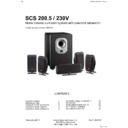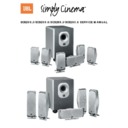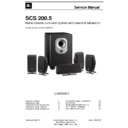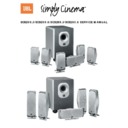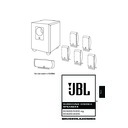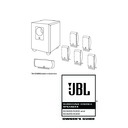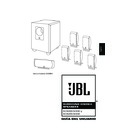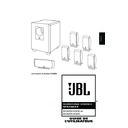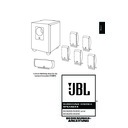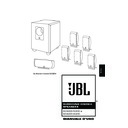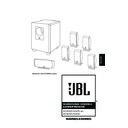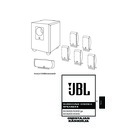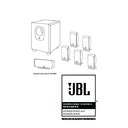JBL SCS 200 (serv.man13) Service Manual ▷ View online
3
antenna discharge unit, size of
grounding conductors, location of
antenna-discharge unit, connection
to grounding electrodes, and require-
ments for the grounding electrode.
See Figure A.
18. An outside antenna system should
not be located in the vicinity of over-
head power lines or other electric
light or power circuits, or where it
can fall into such power lines or cir-
cuits. When installing an outside
antenna system, extreme care should
be taken to keep from touching such
power lines or circuits, as contact
with them might be fatal.
19. Specifications: All product
specifications/features are subject to
change without notification.
grounding conductors, location of
antenna-discharge unit, connection
to grounding electrodes, and require-
ments for the grounding electrode.
See Figure A.
18. An outside antenna system should
not be located in the vicinity of over-
head power lines or other electric
light or power circuits, or where it
can fall into such power lines or cir-
cuits. When installing an outside
antenna system, extreme care should
be taken to keep from touching such
power lines or circuits, as contact
with them might be fatal.
19. Specifications: All product
specifications/features are subject to
change without notification.
Passive Products:
20. Amplifiers: Amplifiers used to
drive these units must deliver a suffi-
cient output power. A lack of output
power may lead to amplifier-clipping,
which causes damage not covered by
guarantee.
20. Amplifiers: Amplifiers used to
drive these units must deliver a suffi-
cient output power. A lack of output
power may lead to amplifier-clipping,
which causes damage not covered by
guarantee.
Active (Powered) Products:
21. Ventilation. Slots and openings in
the cabinet are provided for ventila-
tion and to ensure reliable operation
of the product and to protect it from
overheating, and these openings
must not be blocked or covered. The
openings should never be blocked by
placing the product on a bed, sofa,
rug, or other similar surface. This
product should not be placed in a
built-in installation such as a book-
case or rack unless proper ventilation
is provided or the manufacturer’s
instructions have been adhered to.
Make certain that the proper space
(more than 10cm) is provided both
above and below the unit for ventila-
tion. If the amplifier will be installed in
a cabinet or other enclosed area,
make certain that there is sufficient
air movement within the cabinet, with
means provided for hot air to exit and
for cool air to be brought in.
Do not obstruct the ventilation slots
on the top of the unit or place objects
directly over them. Remember, power
amplifiers generate heat, and the
heatsink fins and ventilation slots that
form part of the cabinet are specially
designed to remove this heat. Placing
other electronic equipment near
these heat-dissipation systems may
possibly affect the long term reliabil-
ity of both your amplifier and the
objects placed above it. Do not place
CDs, record jackets, owner’s manuals
or other paper on top of or beneath
the unit or in between products con-
taining amplifiers in a stack. This will
block the air flow, causing degraded
performance and a possible fire haz-
ard.
21. Ventilation. Slots and openings in
the cabinet are provided for ventila-
tion and to ensure reliable operation
of the product and to protect it from
overheating, and these openings
must not be blocked or covered. The
openings should never be blocked by
placing the product on a bed, sofa,
rug, or other similar surface. This
product should not be placed in a
built-in installation such as a book-
case or rack unless proper ventilation
is provided or the manufacturer’s
instructions have been adhered to.
Make certain that the proper space
(more than 10cm) is provided both
above and below the unit for ventila-
tion. If the amplifier will be installed in
a cabinet or other enclosed area,
make certain that there is sufficient
air movement within the cabinet, with
means provided for hot air to exit and
for cool air to be brought in.
Do not obstruct the ventilation slots
on the top of the unit or place objects
directly over them. Remember, power
amplifiers generate heat, and the
heatsink fins and ventilation slots that
form part of the cabinet are specially
designed to remove this heat. Placing
other electronic equipment near
these heat-dissipation systems may
possibly affect the long term reliabil-
ity of both your amplifier and the
objects placed above it. Do not place
CDs, record jackets, owner’s manuals
or other paper on top of or beneath
the unit or in between products con-
taining amplifiers in a stack. This will
block the air flow, causing degraded
performance and a possible fire haz-
ard.
22. Power Sources. This product
should be operated only from the type
of power source indicated on the
marking label. If you are not sure of
the type of power supply to your
home, consult your product dealer or
local power company. For products
intended to operate from battery
power, or other sources, refer to the
operating instructions.
23. Grounding or Polarization. This
product may be equipped with a polar-
ized alternating-current line plug (a
plug having one blade wider than the
other). This plug will fit into the power
outlet only one way. This is a safety
feature. If you are unable to insert the
plug fully into the outlet, try reversing
the plug. If the plug should still fail to
fit, contact your electrician to replace
your obsolete outlet. Do not defeat the
safety purpose of the polarized plug.
24. Power-Cord Protection. Power-
supply cords should be routed so that
they are not likely to be walked on or
pinched by items placed upon or
against them, paying particular atten-
tion to cords at plugs, convenience
receptacles, and the point where
they exit from the product. To avoid
safety hazards, use only the power
cord supplied with your unit. If a
replacement cord is used, make cer-
tain that it is of a similar gauge. We
do not recommend using extension
cords with this product. As with all
electrical devices, do not run power
cords under rugs or carpets or place
heavy objects on power cords. Dam-
aged power cords should be replaced
immediately, by a qualified service
technician, with cords meeting fac-
tory specifications. When discon-
necting the power cord from an AC
outlet, always pull the plug; never pull
the cord.
25. Non-use Periods. The power cord
of the product should be unplugged
from the outlet when left unused for
long periods of time.
26. Lightning. For added protection
for this product during a lightning
storm, or when it is left unattended
and unused for long periods of time,
unplug it from the wall outlet and dis-
connect the antenna or cable system.
This will prevent damage to the prod-
uct due to lightning and power-line
surges.
27. Overloading. Do not overload wall
outlets, extension cords, or integral
convenience receptacles, as this can
result in a risk of fire or electric shock.
should be operated only from the type
of power source indicated on the
marking label. If you are not sure of
the type of power supply to your
home, consult your product dealer or
local power company. For products
intended to operate from battery
power, or other sources, refer to the
operating instructions.
23. Grounding or Polarization. This
product may be equipped with a polar-
ized alternating-current line plug (a
plug having one blade wider than the
other). This plug will fit into the power
outlet only one way. This is a safety
feature. If you are unable to insert the
plug fully into the outlet, try reversing
the plug. If the plug should still fail to
fit, contact your electrician to replace
your obsolete outlet. Do not defeat the
safety purpose of the polarized plug.
24. Power-Cord Protection. Power-
supply cords should be routed so that
they are not likely to be walked on or
pinched by items placed upon or
against them, paying particular atten-
tion to cords at plugs, convenience
receptacles, and the point where
they exit from the product. To avoid
safety hazards, use only the power
cord supplied with your unit. If a
replacement cord is used, make cer-
tain that it is of a similar gauge. We
do not recommend using extension
cords with this product. As with all
electrical devices, do not run power
cords under rugs or carpets or place
heavy objects on power cords. Dam-
aged power cords should be replaced
immediately, by a qualified service
technician, with cords meeting fac-
tory specifications. When discon-
necting the power cord from an AC
outlet, always pull the plug; never pull
the cord.
25. Non-use Periods. The power cord
of the product should be unplugged
from the outlet when left unused for
long periods of time.
26. Lightning. For added protection
for this product during a lightning
storm, or when it is left unattended
and unused for long periods of time,
unplug it from the wall outlet and dis-
connect the antenna or cable system.
This will prevent damage to the prod-
uct due to lightning and power-line
surges.
27. Overloading. Do not overload wall
outlets, extension cords, or integral
convenience receptacles, as this can
result in a risk of fire or electric shock.
28. Damage Requiring Service. Do
not attempt to service this product
yourself, as opening or removing cov-
ers may expose you to dangerous
voltage or other hazards. Unplug this
product from the wall outlet and refer
servicing to qualified service person-
nel under the following conditions:
a. The power-supply cord or the plug
not attempt to service this product
yourself, as opening or removing cov-
ers may expose you to dangerous
voltage or other hazards. Unplug this
product from the wall outlet and refer
servicing to qualified service person-
nel under the following conditions:
a. The power-supply cord or the plug
has been damaged; or
b. Objects have fallen, or liquid has
been spilled into, the product; or
c. The product has been exposed to
rain or water; or
d. The product does not operate nor-
mally when following the operating
instructions. Adjust only those con-
trols that are covered by the oper-
ating instructions, as an improper
adjustment of other
controls may result in damage and
will often require extensive work by
a qualified technician to restore the
product to its normal operation; or
instructions. Adjust only those con-
trols that are covered by the oper-
ating instructions, as an improper
adjustment of other
controls may result in damage and
will often require extensive work by
a qualified technician to restore the
product to its normal operation; or
e. The product has been dropped, or
the enclosure damaged; or
f. The product does not appear to
operate normally or exhibits a
marked change in performance.
marked change in performance.
29. Object and Liquid Entry. Never
push objects of any kind into this prod-
uct through openings, as they may
touch dangerous voltage points or
short-out parts that could result in a
fire or electric shock. Never spill liquid
of any kind on the product. The appa-
ratus shall not be exposed to dripping
or splashing and no objects filled with
liquids, such as vases, shall be placed
on the apparatus.
30. Heat. The product should be situ-
ated away from heat sources such as
radiators, heat registers, stoves or
other products (including amplifiers)
that produce heat. Avoid installation
in extremely hot or cold locations, in
an area that is exposed to direct sun-
light or near heating equipment.
When positioning the product in its
final location, make certain that it has
adequate ventilation on all sides, as
well as on the top and bottom.
push objects of any kind into this prod-
uct through openings, as they may
touch dangerous voltage points or
short-out parts that could result in a
fire or electric shock. Never spill liquid
of any kind on the product. The appa-
ratus shall not be exposed to dripping
or splashing and no objects filled with
liquids, such as vases, shall be placed
on the apparatus.
30. Heat. The product should be situ-
ated away from heat sources such as
radiators, heat registers, stoves or
other products (including amplifiers)
that produce heat. Avoid installation
in extremely hot or cold locations, in
an area that is exposed to direct sun-
light or near heating equipment.
When positioning the product in its
final location, make certain that it has
adequate ventilation on all sides, as
well as on the top and bottom.
JBL
SCS200.5/230 Service Manual
Page 4 of 53
4
INCLUDED
THANK YOU FOR CHOOSING JBL
For more than 50 years, JBL
has been involved in every
aspect of music and film
recording and reproduction,
from live performances to
the recordings you play in
your home, car or office.
has been involved in every
aspect of music and film
recording and reproduction,
from live performances to
the recordings you play in
your home, car or office.
We’re confident that the JBL
system you have chosen will
provide every note of enjoy-
system you have chosen will
provide every note of enjoy-
ment that you expected –
and that when you think
about purchasing additional
audio equipment for your
home, car or office, you will
once again choose JBL.
and that when you think
about purchasing additional
audio equipment for your
home, car or office, you will
once again choose JBL.
Please take a moment to
register your product on our
Web site at www.jbl.com.
It enables us to keep you
register your product on our
Web site at www.jbl.com.
It enables us to keep you
posted on our latest advance-
ments, and helps us to better
understand our customers
and build products that
meet their needs and
expectations.
ments, and helps us to better
understand our customers
and build products that
meet their needs and
expectations.
JBL Consumer Products
Five (four in SCS200.5 system)
satellites for left, right and
surrounds. Wall-mount brackets.
Shelf stands.
satellites for left, right and
surrounds. Wall-mount brackets.
Shelf stands.
One center channel speaker with
shelf stand.
shelf stand.
Powered subwoofer.
Three 6m (20') speaker cables for con-
nection to front, left, center and right
speakers, or to subwoofer when
speaker-level connections are used
(see page 10).
nection to front, left, center and right
speakers, or to subwoofer when
speaker-level connections are used
(see page 10).
Two 4.6m (15') speaker cables for con-
nection from subwoofer to front speak-
ers, when speaker-level connections
are used (see page 10).
nection from subwoofer to front speak-
ers, when speaker-level connections
are used (see page 10).
Three (two in SCS200.5 system) 12m
(40') speaker cables for connection
from receiver to rear satellites.
(40') speaker cables for connection
from receiver to rear satellites.
One 4.6m (15') RCA interconnect cable
for connection from receiver to sub-
woofer’s LFE input.
for connection from receiver to sub-
woofer’s LFE input.
JBL
SCS200.5/230 Service Manual
Page 5 of 53
5
SPEAKER PLACEMENT
SUBWOOFER
SURROUND SPEAKERS
†
1.5 – 1.8m
5 – 6 ft
†
FRONT
SPEAKERS
SPEAKERS
0-0.6m
0-2 ft
The front speakers should be
placed the same distance
from each other as they are
from the listening position.
They should be placed at
about the same height from
the floor as the listeners’
ears will be, or they may be
angled toward the listeners.
placed the same distance
from each other as they are
from the listening position.
They should be placed at
about the same height from
the floor as the listeners’
ears will be, or they may be
angled toward the listeners.
The center channel speaker
should be placed slightly
behind the front left and right
speakers, and no more than
two feet above or below the
tweeters of the left and right
speakers. It is often con-
venient to set the center
speaker on top of the tele-
vision set, as shown in the
drawing.
should be placed slightly
behind the front left and right
speakers, and no more than
two feet above or below the
tweeters of the left and right
speakers. It is often con-
venient to set the center
speaker on top of the tele-
vision set, as shown in the
drawing.
Two of the surround speak-
ers should be placed slightly
behind the listening position
and, ideally, should face
each other and be at a level
ers should be placed slightly
behind the listening position
and, ideally, should face
each other and be at a level
higher than the listeners’
ears. If that is not possible,
they may be placed on a wall
behind the listening position,
facing forward. The surround
back speaker (SCS200.6 sys-
tem only) should be placed
on the wall behind the listen-
ing position, facing the cen-
ter channel speaker. The sur-
round speakers should not
call attention to themselves.
Experiment with their place-
ment until you hear a diffuse,
ambient sound accom-
panying the mainprogram
material heard in the front
speakers.
ears. If that is not possible,
they may be placed on a wall
behind the listening position,
facing forward. The surround
back speaker (SCS200.6 sys-
tem only) should be placed
on the wall behind the listen-
ing position, facing the cen-
ter channel speaker. The sur-
round speakers should not
call attention to themselves.
Experiment with their place-
ment until you hear a diffuse,
ambient sound accom-
panying the mainprogram
material heard in the front
speakers.
It is neither necessary nor
desirable to tilt the surround
speakers to aim them down
toward the listening area.
They should be aimed
straight ahead to produce
the proper effect.
desirable to tilt the surround
speakers to aim them down
toward the listening area.
They should be aimed
straight ahead to produce
the proper effect.
The low-frequency material
reproduced by the sub-
woofer is mostly omnidirec-
tional, and this speaker may
be placed in a convenient
location in the room. How-
ever, bass reproduction will
be maximized when the sub-
woofer is placed in a corner
along the same wall as the
front speakers. Experiment
with subwoofer placement
by temporarily placing the
subwoofer in the listening
position and moving around
the room until the bass
reproduction is best. Place
the subwoofer in that loca-
tion.
reproduced by the sub-
woofer is mostly omnidirec-
tional, and this speaker may
be placed in a convenient
location in the room. How-
ever, bass reproduction will
be maximized when the sub-
woofer is placed in a corner
along the same wall as the
front speakers. Experiment
with subwoofer placement
by temporarily placing the
subwoofer in the listening
position and moving around
the room until the bass
reproduction is best. Place
the subwoofer in that loca-
tion.
CENTER CHANNEL
SPEAKER
SPEAKER
Alternate placement for surround speakers in SCS200.5
system only.
system only.
†
Surround back speaker is used
only in SCS200.6 system.
only in SCS200.6 system.
JBL
SCS200.5/230 Service Manual
Page 6 of 53
6
MOUNTING OPTIONS
On shelves.
On the wall.
Wall brackets are included.
Wall brackets are included.
On optional stands.
SATELLITES AND SURROUNDS
Prepare the speaker wire as
described on page 8. Thread
the two conductors through
the two holes in the stand
bracket. Make sure to pre-
serve the proper polarity
(+ and – connections) by
threading the positive con-
described on page 8. Thread
the two conductors through
the two holes in the stand
bracket. Make sure to pre-
serve the proper polarity
(+ and – connections) by
threading the positive con-
ductor through the hole on
the left, and the negative
conductor through the hole
on the right looking at the
front of the stand. Push
down on the red speaker ter-
minal and insert the bare end
of the positive wire into the
the left, and the negative
conductor through the hole
on the right looking at the
front of the stand. Push
down on the red speaker ter-
minal and insert the bare end
of the positive wire into the
hole under the red cap.
Release the cap, and tug
gently on the wire to make
sure that the connection is
snug. Follow the same pro-
cedure to connect the nega-
tive wire to its terminal.
Release the cap, and tug
gently on the wire to make
sure that the connection is
snug. Follow the same pro-
cedure to connect the nega-
tive wire to its terminal.
ATTACHING THE SHELF STAND TO THE SPEAKER
+
–
Gently pull the slack out of
the wire and screw the shelf
stand onto the back of the
speaker in two places, as
shown.
the wire and screw the shelf
stand onto the back of the
speaker in two places, as
shown.
JBL
SCS200.5/230 Service Manual
Page 7 of 53

